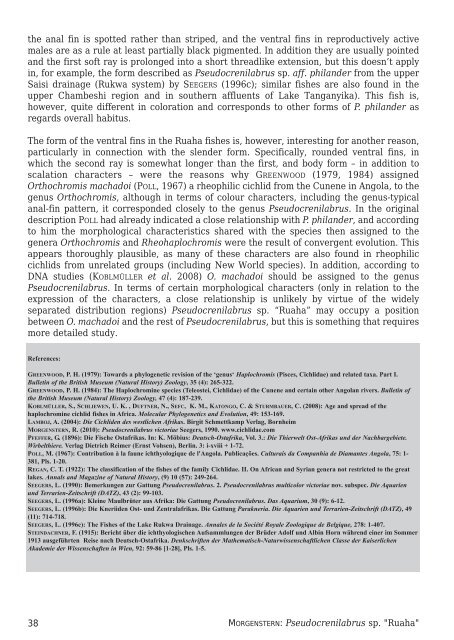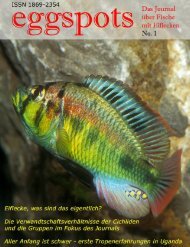Eggspots Elsewhere - Welt der Fische / World of Fishes
Eggspots Elsewhere - Welt der Fische / World of Fishes
Eggspots Elsewhere - Welt der Fische / World of Fishes
Create successful ePaper yourself
Turn your PDF publications into a flip-book with our unique Google optimized e-Paper software.
the anal fin is spotted rather than striped, and the ventral fins in reproductively active<br />
males are as a rule at least partially black pigmented. In addition they are usually pointed<br />
and the first s<strong>of</strong>t ray is prolonged into a short threadlike extension, but this doesn’t apply<br />
in, for example, the form described as Pseudocrenilabrus sp. aff. philan<strong>der</strong> from the upper<br />
Saisi drainage (Rukwa system) by SEEGERS (1996c); similar fishes are also found in the<br />
upper Chambeshi region and in southern affluents <strong>of</strong> Lake Tanganyika). This fish is,<br />
however, quite different in coloration and corresponds to other forms <strong>of</strong> P. philan<strong>der</strong> as<br />
regards overall habitus.<br />
The form <strong>of</strong> the ventral fins in the Ruaha fishes is, however, interesting for another reason,<br />
particularly in connection with the slen<strong>der</strong> form. Specifically, rounded ventral fins, in<br />
which the second ray is somewhat longer than the first, and body form – in addition to<br />
scalation characters – were the reasons why GREENWOOD (1979, 1984) assigned<br />
Orthochromis machadoi (POLL, 1967) a rheophilic cichlid from the Cunene in Angola, to the<br />
genus Orthochromis, although in terms <strong>of</strong> colour characters, including the genus-typical<br />
anal-fin pattern, it corresponded closely to the genus Pseudocrenilabrus. In the original<br />
description POLL had already indicated a close relationship with P. philan<strong>der</strong>, and according<br />
to him the morphological characteristics shared with the species then assigned to the<br />
genera Orthochromis and Rheohaplochromis were the result <strong>of</strong> convergent evolution. This<br />
appears thoroughly plausible, as many <strong>of</strong> these characters are also found in rheophilic<br />
cichlids from unrelated groups (including New <strong>World</strong> species). In addition, according to<br />
DNA studies (KOBLMÜLLER et al. 2008) O. machadoi should be assigned to the genus<br />
Pseudocrenilabrus. In terms <strong>of</strong> certain morphological characters (only in relation to the<br />
expression <strong>of</strong> the characters, a close relationship is unlikely by virtue <strong>of</strong> the widely<br />
separated distribution regions) Pseudocrenilabrus sp. “Ruaha” may occupy a position<br />
between O. machadoi and the rest <strong>of</strong> Pseudocrenilabrus, but this is something that requires<br />
more detailed study.<br />
References:<br />
GREENWOOD, P. H. (1979): Towards a phylogenetic revision <strong>of</strong> the ‘genus‘ Haplochromis (Pisces, Cichlidae) and related taxa. Part I.<br />
Bulletin <strong>of</strong> the British Museum (Natural History) Zoology, 35 (4): 265-322.<br />
GREENWOOD, P. H. (1984): The Haplochromine species (Teleostei, Cichlidae) <strong>of</strong> the Cunene and certain other Angolan rivers. Bulletin <strong>of</strong><br />
the British Museum (Natural History) Zoology, 47 (4): 187-239.<br />
KOBLMÜLLER, S., SCHLIEWEN, U. K. , DUFTNER, N., SEFC, K. M., KATONGO, C. & STURMBAUER, C. (2008): Age and spread <strong>of</strong> the<br />
haplochromine cichlid fishes in Africa. Molecular Phylogenetics and Evolution, 49: 153-169.<br />
LAMBOJ, A. (2004): Die Cichliden des westlichen Afrikas. Birgit Schmettkamp Verlag, Bornheim<br />
MORGENSTERN, R. (2010): Pseudocrenilabrus victoriae Seegers, 1990. www.cichlidae.com<br />
PFEFFER, G. (1896): Die <strong>Fische</strong> Ostafrikas. In: K. Möbius: Deutsch-Ostafrika, Vol. 3.: Die Thierwelt Ost-Afrikas und <strong>der</strong> Nachbargebiete.<br />
Wirbelthiere. Verlag Dietrich Reimer (Ernst Vohsen), Berlin. 3: i-xviii + 1-72.<br />
POLL, M. (1967): Contribution à la faune ichthyologique de l'Angola. Publicações. Culturais da Companhia de Diamantes Angola, 75: 1-<br />
381, Pls. 1-20.<br />
REGAN, C. T. (1922): The classification <strong>of</strong> the fishes <strong>of</strong> the family Cichlidae. II. On African and Syrian genera not restricted to the great<br />
lakes. Annals and Magazine <strong>of</strong> Natural History, (9) 10 (57): 249-264.<br />
SEEGERS, L. (1990): Bemerkungen zur Gattung Pseudocrenilabrus. 2. Pseudocrenilabrus multicolor victoriae nov. subspec. Die Aquarien<br />
und Terrarien-Zeitschrift (DATZ), 43 (2): 99-103.<br />
SEEGERS, L. (1996a): Kleine Maulbrüter aus Afrika: Die Gattung Pseudocrenilabrus. Das Aquarium, 30 (9): 6-12.<br />
SEEGERS, L. (1996b): Die Kneriiden Ost- und Zentralafrikas. Die Gattung Parakneria. Die Aquarien und Terrarien-Zeitschrift (DATZ), 49<br />
(11): 714-718.<br />
SEEGERS, L. (1996c): The <strong>Fishes</strong> <strong>of</strong> the Lake Rukwa Drainage. Annales de la Société Royale Zoologique de Belgique, 278: 1-407.<br />
STEINDACHNER, F. (1915): Bericht über die ichthyologischen Aufsammlungen <strong>der</strong> Brü<strong>der</strong> Adolf und Albin Horn während einer im Sommer<br />
1913 ausgeführten Reise nach Deutsch-Ostafrika. Denkschriften <strong>der</strong> Mathematisch-Naturwissenschaftlichen Classe <strong>der</strong> Kaiserlichen<br />
Akademie <strong>der</strong> Wissenschaften in Wien, 92: 59-86 [1-28], Pls. 1-5.<br />
38<br />
MORGENSTERN: Pseudocrenilabrus sp. "Ruaha"




